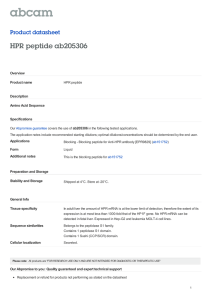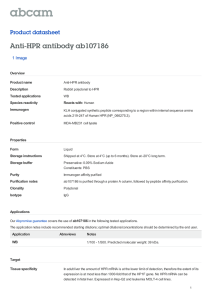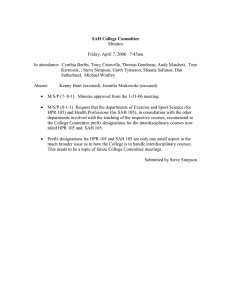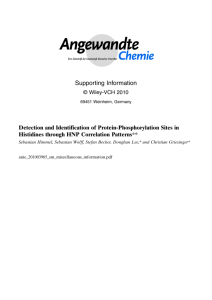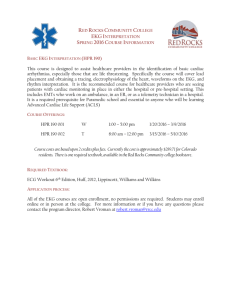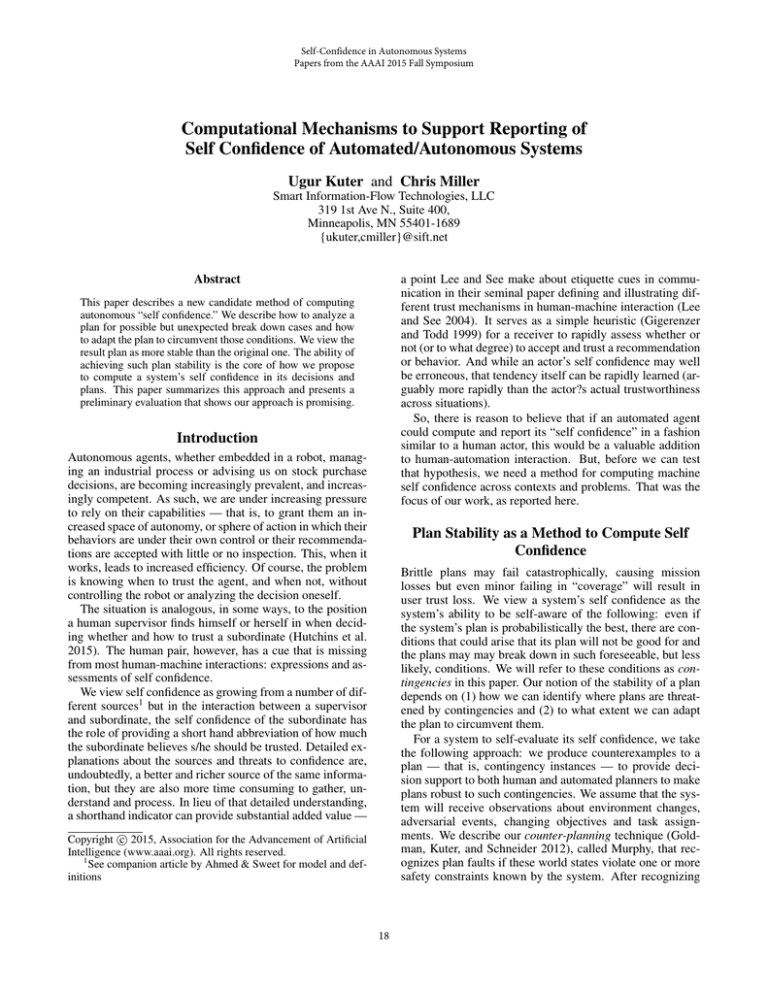
Self-Confidence in Autonomous Systems
Papers from the AAAI 2015 Fall Symposium
Computational Mechanisms to Support Reporting of
Self Confidence of Automated/Autonomous Systems
Ugur Kuter and Chris Miller
Smart Information-Flow Technologies, LLC
319 1st Ave N., Suite 400,
Minneapolis, MN 55401-1689
{ukuter,cmiller}@sift.net
Abstract
a point Lee and See make about etiquette cues in communication in their seminal paper defining and illustrating different trust mechanisms in human-machine interaction (Lee
and See 2004). It serves as a simple heuristic (Gigerenzer
and Todd 1999) for a receiver to rapidly assess whether or
not (or to what degree) to accept and trust a recommendation
or behavior. And while an actor’s self confidence may well
be erroneous, that tendency itself can be rapidly learned (arguably more rapidly than the actor?s actual trustworthiness
across situations).
So, there is reason to believe that if an automated agent
could compute and report its “self confidence” in a fashion
similar to a human actor, this would be a valuable addition
to human-automation interaction. But, before we can test
that hypothesis, we need a method for computing machine
self confidence across contexts and problems. That was the
focus of our work, as reported here.
This paper describes a new candidate method of computing
autonomous “self confidence.” We describe how to analyze a
plan for possible but unexpected break down cases and how
to adapt the plan to circumvent those conditions. We view the
result plan as more stable than the original one. The ability of
achieving such plan stability is the core of how we propose
to compute a system’s self confidence in its decisions and
plans. This paper summarizes this approach and presents a
preliminary evaluation that shows our approach is promising.
Introduction
Autonomous agents, whether embedded in a robot, managing an industrial process or advising us on stock purchase
decisions, are becoming increasingly prevalent, and increasingly competent. As such, we are under increasing pressure
to rely on their capabilities — that is, to grant them an increased space of autonomy, or sphere of action in which their
behaviors are under their own control or their recommendations are accepted with little or no inspection. This, when it
works, leads to increased efficiency. Of course, the problem
is knowing when to trust the agent, and when not, without
controlling the robot or analyzing the decision oneself.
The situation is analogous, in some ways, to the position
a human supervisor finds himself or herself in when deciding whether and how to trust a subordinate (Hutchins et al.
2015). The human pair, however, has a cue that is missing
from most human-machine interactions: expressions and assessments of self confidence.
We view self confidence as growing from a number of different sources1 but in the interaction between a supervisor
and subordinate, the self confidence of the subordinate has
the role of providing a short hand abbreviation of how much
the subordinate believes s/he should be trusted. Detailed explanations about the sources and threats to confidence are,
undoubtedly, a better and richer source of the same information, but they are also more time consuming to gather, understand and process. In lieu of that detailed understanding,
a shorthand indicator can provide substantial added value —
Plan Stability as a Method to Compute Self
Confidence
Brittle plans may fail catastrophically, causing mission
losses but even minor failing in “coverage” will result in
user trust loss. We view a system’s self confidence as the
system’s ability to be self-aware of the following: even if
the system’s plan is probabilistically the best, there are conditions that could arise that its plan will not be good for and
the plans may may break down in such foreseeable, but less
likely, conditions. We will refer to these conditions as contingencies in this paper. Our notion of the stability of a plan
depends on (1) how we can identify where plans are threatened by contingencies and (2) to what extent we can adapt
the plan to circumvent them.
For a system to self-evaluate its self confidence, we take
the following approach: we produce counterexamples to a
plan — that is, contingency instances — to provide decision support to both human and automated planners to make
plans robust to such contingencies. We assume that the system will receive observations about environment changes,
adversarial events, changing objectives and task assignments. We describe our counter-planning technique (Goldman, Kuter, and Schneider 2012), called Murphy, that recognizes plan faults if these world states violate one or more
safety constraints known by the system. After recognizing
c 2015, Association for the Advancement of Artificial
Copyright Intelligence (www.aaai.org). All rights reserved.
1
See companion article by Ahmed & Sweet for model and definitions
18
>#.$+,)
?,+#)
!"#$#%&#'()
*#+,(-.-)
/01234(5)
@"2,8)A<+<&)
B+2.+=,&-)C)
D+#%&-)
62&+78"9#)
!"#$#%&#'()
:);)#)
/9.<4)
32"=+=.,.$&-5)
lation procedure follows immediately from its construction.
Given access to a sound and complete classical planner, we
have a sound and complete algorithm for deciding a counter
planning problem as defined above.
E>)
62&+78"9#)
'+-&-)C)2&3+.2)
-1%%&-$"#-)
/F,<&2&8)"2)
"28&2&8)=()
32."2.<(5)
Hierarchical Plan Repair
Once the possible contingencies on a plan are identified by
Murphy, we proceed to generate ways to adapt the plan to
alleviate those contingencies, should they happen. We believe that the ability to adapt the plan to all or most of the
known or identified contingencies should boost the system’s
self confidence for two reasons: (1) adapting the plan to
the identified contingencies makes the plan more robust, and
therefore, increases the likelihood that the plan will succeed
in execution; and (2) the system increases its belief that it
may be able to adapt to any contingency that is learned or
identified later.
We use a hierarchical planning and plan repair (HPR),
based on our previous works on HOTRiDE and SHOPLifter
systems. HPR is based on the well-known Hierarchical Task
Network (HTN) planning paradigm (Erol, Hendler, and Nau
1994; Nau et al. 2003). The purpose of an HTN planner is
to produce a sequence of actions that perform some activity or task. The description of a planning domain includes
a set of planning operators and methods, each of which is a
prescription for how to decompose a task into its subtasks
(smaller tasks). The description of a planning problem contains an initial state as in classical planning. Instead of a goal
formula, however, there is a partially-ordered set of tasks to
accomplish. Planning proceeds by decomposing tasks recursively into smaller and smaller sub-tasks, until primitive
tasks, which can be performed directly using the planning
operators, are reached. For nonprimitive each task, the planner chooses an applicable method, instantiates it to decompose the task into subtasks, and then chooses and instantiates
other methods to decompose the subtasks even further. If the
constraints on the sub- tasks or the interactions among them
prevent the plan from being feasible, the planning system
backtracks and tries other methods.
In addition to a plan (i.e., a sequence of actions) for
an input HTN planning problem, HPR also returns a taskdependency graph. The task-dependency graph generated
by HPR consists of the hierarchy of tasks decomposed and
generated by an HTN planner to find a plan, and it holds information about the dependencies among those tasks in the
hierarchy. We represent such dependencies between tasks
via the causal links among them. Using these causal links,
HPR can determine which parts of the plan are affected by
the result of a certain operator application. If an action fails
during execution, these causal links help HPR to find which
decompositions in the HTN trace are not valid anymore and
need to be replanned.
When a contingency is identified for an action in the solution plan, HPR checks every parent of the failed action using
the dependency graph generated before. The algorithm first
identifies the minimal failed parent, a nonprimitive task t in
the dependency graph, and it attempts to generate a new decomposition for t. Then it identifies the set of causal links
in the current dependency graph that are supported by the
?,+##&2)
Figure 1: A high-level function view of our computational
approach to measure the self confidence of a system and its
user interactions.
a fault, our approach uses hierarchical re-pair techniques,
based on our previous work on HOTRiDE (Ayan et al. 2007)
and SHOPLifter (Kuter 2012) to localize and fix the error. Our hierarchical plan repair techniques walk up the
task structure of a plan, trying small fixes first, then expanding. Once this generates contingency libraries, it transforms
both counter-plans and world-state knowledge into operational behavior models for the users’ review and for autonomy planners and managers as well. Figure 1 shows a highlevel functional description of our computational approach.
Below, we describe the major technical components in this
architecture.
Murphy: Analyzing Contingencies in Plans
Murphy takes a representation of the initial plan and a planning domain definition consisting of a set of exogenous
events (e.g., the actions of other agents, the actions of “nature,” etc.). We then treat these components as a disjunctive
planning problem and can use any AI planner to find counterexamples to illustrate ways in which a plan may go awry
in execution.
Murphy translates a plan into what we call a “counter
planning” problem, combining a representation of the initial
plan with the definition of a set of exogenous events. In particular, we developed a translation that takes as input (1) a
formal description of planning domain written in the widelyknown PDDL (Planning Domain Description Language) in
AI planning (McDermott 1998; Fox and Long 2001); (2) a
PDDL planning problem; (3) a plan that solves the domain
+ problem; (4) a counter planning domain extension with
new objects and planning operators for exogenous events.
The translation yields a new counter planning problem and
domain that can be solved to find a counterexample or, if
searched exhaustively without finding a trace, indicates that
no counterexample exists. There are three components to
the translation process: (1) generating a “skeleton” for the
original plan that ensures that the original plan actions occur
in the proper order; (2) formulating a goal expression that
will cause a planner to search for a counterexample and (3)
encoding the resulting disjunctive goal expression in a way
that is amenable to the use of a standard PDDL planner.
The details of our translation and a comprehensive experimental evaluation of Murphy is described in (Goldman,
Kuter, and Schneider 2012). The soundness of our trans-
19
plan originally generated for t. Then, HPR generates a new
plan for t and its corresponding dependency graph. Next,
HPR establishes all of the causal links between the any task
in the new dependency graph and the tasks in the previous
dependency graph that are not accomplished yet. After this
operation, there may some tasks in the original dependency
graph that are not supported by the current plan.
If the algorithm generates a new plan in which all the
causal links are satisfied, it resumes the execution of this
new plan, starting from first unexecuted action. Otherwise,
HPR calls it self recursively on the parent task of t in the
plan hierarchy. HPR repeats the plan repair process above
until one of the following holds: either HPR generates a plan
that is executed successfully in the world, or the plan-repair
process marks a goal task as failed. In the latter case, HPR
reports failure.
Original"Plan"
Repaired"Plan"
1"
Self%Confidence%
0.8"
0.6"
0.4"
0.2"
0"
0.005"
0.33"
0.67"
Cloud%Cover%Percentage%
0.9"
Figure 2: Preliminary results on our contingency analysis
and plan repair approach to derive self confidence measures.
Measuring Self Confidence
Given all counter examples for contingencies C, and their
probability of occurrence, and possible adaptations against
those contingencies, we used a simple measure of self confidence in a plan π:
X
P (C 0 ) =
(1.0 − prob(c)),
Preliminary Evaluations
We have implemented a preliminary system based on Murphy and hierarchical plan repair techniques described above.
Our implementation is on Common Lisp. For experiments,
we have developed a multi-UAV Intelligence, Surveillance,
and Reconnaissance (ISR) scenario, in which a group of
UAVs are tasked with flying to a target location and taking
an image of that location. The UAVs may be equipped with
different types of cameras for this task, and we used EO or
IR cameras for our scenarios. For exogenous events that may
break an ISR plan, we modeled weather conditions such as
cloud cover and dust storm, which may occur depending on
the terrain a scenario is taking place.
Figure 2 shows our preliminary results with our approach
in a suite of above ISR scenarios. In this case, the weather
event of a cloud cover forming at the target area so that the
UAVs’ camera’s may not take a picture of their targets. The
results show that as we increase the likelihood of a contingency happening, the adapted plans are more robust to failure compared to the original plan and therefore, the system’s
self confidence in its plans are higher. Note that in both
the original plans and the adapted plans, the self confidence
value drops due to the contingencies, but the rate of the drop
is much higher in the original plan than in the adapted plans.
c∈C
for each counter example c found against π, where
prob(c) = p(f ailure | events); e.g., events might include
cloud cover, high winds, etc.
We assume that a priori probabilities of the possible exogenous events are given as input. For example, weather
forecast might report that there will be a cloud cover at particular location with some probability. We also assume that
every planning operator in he planning domain that Murphy
and HPR works with is associated with a baseline probability of failure – i.e., each action represents a conditional
probability that describes the event that the effects of the action will not be achieved given the preconditions are satisfied
in a particular world state.2 Given this probabilistic model
of the planning domain, we use approximate Bayesian inference (Pearl 1988) to estimate the conditional probability
p(f ailure | events) above.
Note that in cases where HPR can repair the plan against
the exogenous events, the robustness, and therefore the self
confidence, of the plan increases. If HPR fails to produce
a repair and reports a failure, this does not change the self
confidence measure over a plan produced the above computation. Therefore, the self confidence measure about is
monotonically non-decreasing by the amount of adaptation
made by HPR in the system. In those cases where the self
confidence of the system does not change, the system can
report this to the users who can decide if the plan must be
modified against an exogenous event and how.
Conclusions
We have described our approach to compute an autonomous
system’s self confidence in its plans. Our approach uses
two different but complementary automated planning techniques: (1) counter planning to identify likely contingencies
in a plan before those contingencies create a failure during
execution; and (2) plan repair to adapt the plan to prevent
those failures to happen. Together, these techniques make it
a plan more robust and stable to those identified contingencies and provide a self-proof to the system that it can adapt to
failures. We believe such self-proofs constitute the basis of
the system’s self confidence in its operations and output. We
describe a simple probabilistic measure that generates a self
confidence value associated with a plan. Preliminary experiments show that this self confidence measure yields much
2
The reason that we assume a probability of failure instead of a
probability of success for each action is that we believe the former
is easier to produce as input to the system. The successful execution of an action can be disturbed for many reasons, some of which
we may not know a priori. However, we may predict a lower bound
probability of failure for an action, without enumerating all of the
break down cases for it.
20
higher self confidence indeed when the system can adapt its
plans, compared to its self confidence in the original plans.
Acknowledgments. This work was supported under Air
Force Research Laboratory contract #FA8650-09D-3900
Task Order 0015 via a subcontract to Infoscitex Corporation
(IST). SIFT would like to thank Dr. Mark Draper (AFRL)
and Dr. Tom Hughes (IST) for their support and oversight.
References
Ayan, F.; Kuter, U.; Yaman, F.; and Goldman, R. P. 2007.
HOTRiDE: Hierarchical Ordered Task Replanning in Dynamic Environments. In Proceedings of the ICAPS-07 Workshop on Planning and Plan Execution for Real-World Systems – Principles and Practices for Planning in Execution.
Erol, K.; Hendler, J.; and Nau, D. S. 1994. Semantics for
hierarchical task-network planning. Technical Report CS
TR-3239, UMIACS TR-94-31, ISR-TR-95-9, University of
Maryland.
Fox, M., and Long, D. 2001. PDDL+ level5 : An extension
to PDDL2.1 for modeling domains with continuous timedependent effects. technical note, University of Durham.
Gigerenzer, G., and Todd, P. M. 1999. Simple heuristics that
make us smart. Oxford University Press, USA.
Goldman, R. P.; Kuter, U.; and Schneider, A. 2012. Using
classical planners for plan verification and counterexample
generation. In Proceedings of CP4PS-12.
Hutchins, A. R.; Cummings, M.; Draper, M.; and Hughes,
T. 2015. Representing autonomous systems self-confidence
through competency boundaries. Technical report, DTIC
Document.
Kuter, U. 2012. Dynamics of behavior and acting in dynamic environments: Forethought, reaction, and plan repair.
Technical Report 2012-1, SIFT.
Lee, J. D., and See, K. A. 2004. Trust in automation: Designing for appropriate reliance. Human Factors: The Journal of the Human Factors and Ergonomics Society 46(1):50–
80.
McDermott, D. 1998. PDDL, the planning domain definition language. Technical report, Yale Center for Computational Vision and Control.
Nau, D. S.; Au, T.-C.; Ilghami, O.; Kuter, U.; Murdock,
J. W.; Wu, D.; and Yaman, F. 2003. SHOP2: An HTN
planning system. Journal of Artificial Intelligence Research
(JAIR) 20:379–404.
Pearl, J. 1988. Probabilistic Reasoning in Intelligent Systems: Networks of Plausible Inference. San Fransisco, CA:
Morgan Kaufmann.
21

